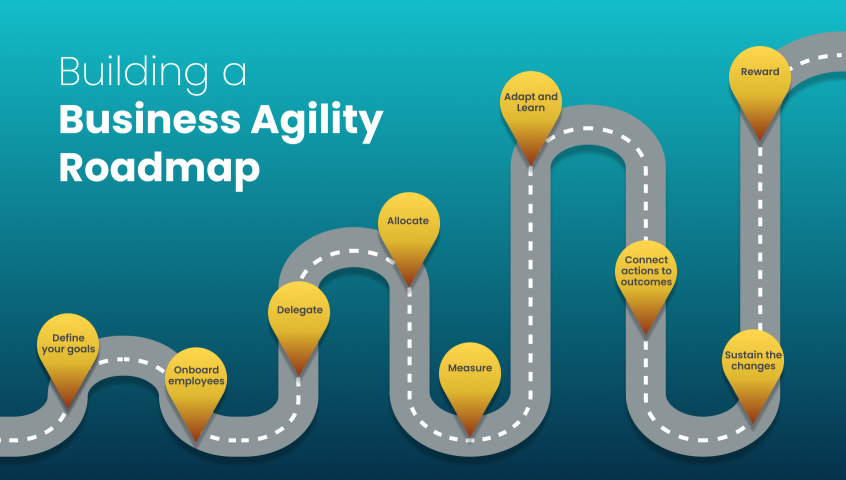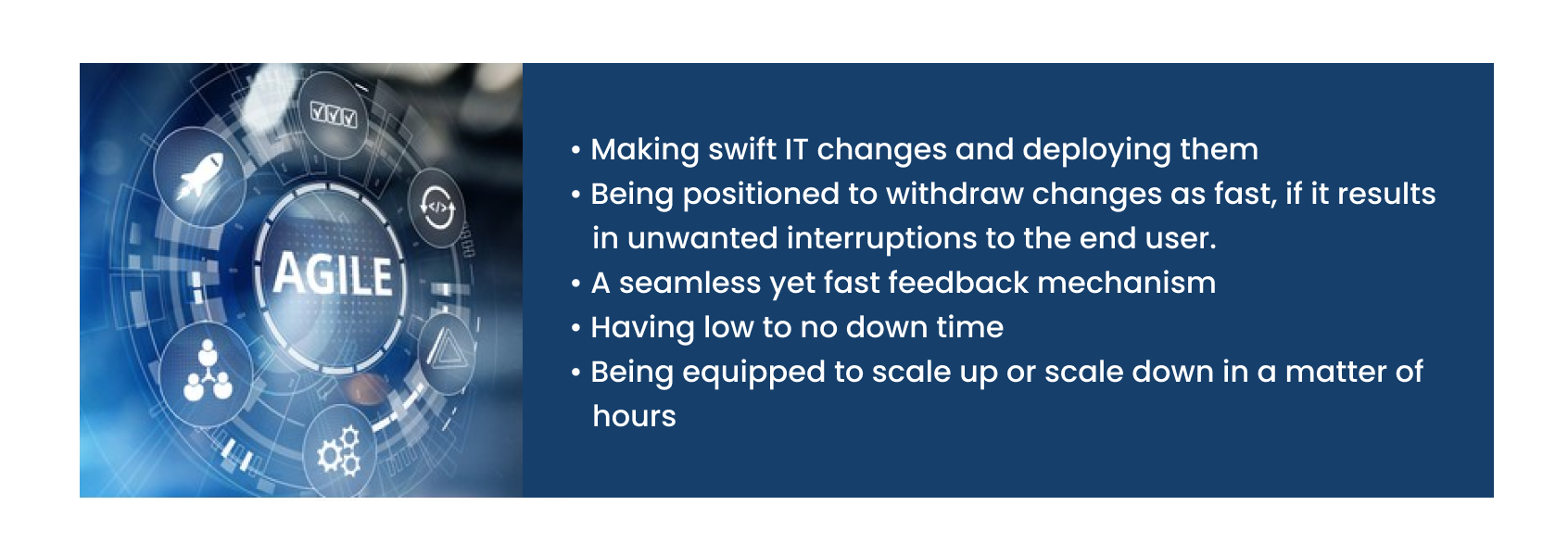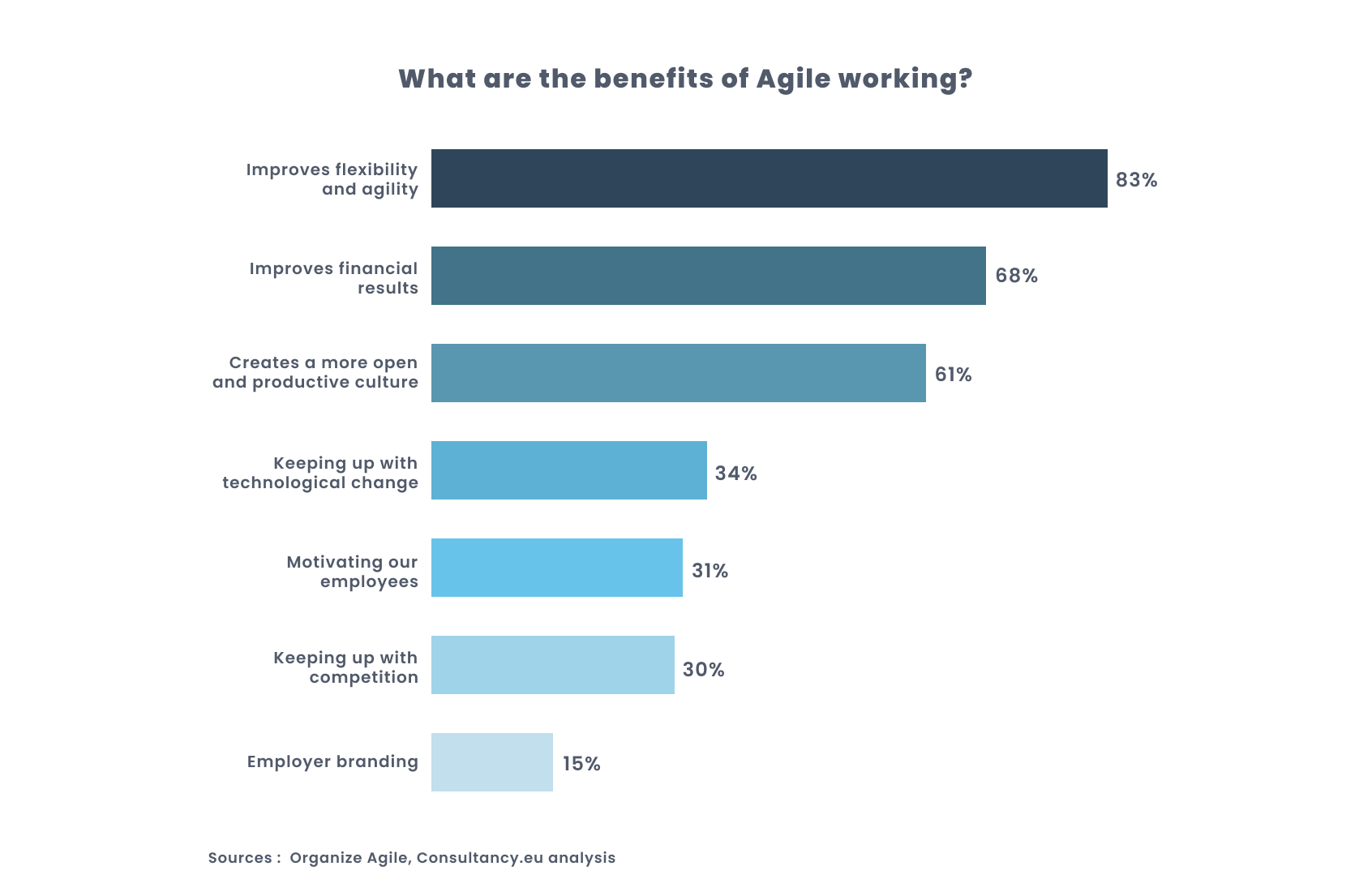
Netflix, Uber, Apple, Amazon, Airbnb – you name it, and if they have made it big – One of their secret sauces is Business Agility! Give us a moment to explain why developing strategy with Business Agility at the crux is critical to today's businesses. Each one of these businesses relies on their cutting-edge software and technology as a key competitive weapon. But also, they moved away from the traditional waterfall approach and transformed to think faster, be responsive, and create compelling user experiences. They opted to be agile!
Business agility is the new watchword among the top decision-making circles of every organization. There are meetings to discuss and contemplate how they can all bring ‘agility’ to their existing technologies. The big three tech trends – mobility, cloud computing, and the Internet of Things – have established that digital is the only way forward. To keep pace, organizations will need to adapt in real-time with zero downtime and keep thriving in a data-rich environment.
But before we can get started on how can a company build a business agility roadmap, let’s understand what agility means –

In a nutshell, business agility enables organizations to better respond to change and manage uncertainty.
If you were to take a deeper look into where an agile organization differs from a traditional one, you would observe that a traditional organization is built around a siloed, structural hierarchy. Whereas, an agile business operates based on fast learning and decision-making cycles. Traditional organizations put decision-making bodies right at the helm and decision flows from the top. On the contrary, agile models use data in real-time to plant decision-making right at the center of the team that is closest to the information.
The below graph gives an insight into what are the benefits of agile working and once through it, we would jump straight into how to build a business agility roadmap.

The roadmap to agility
Business agility cannot be adopted and implemented overnight. Building an agile environment requires efforts, planning, and most importantly – a roadmap. While there are several steps to build a roadmap, but we recommend a nine-step agility roadmap.
Step 1 – Define your goals
Needless to mention that without a vision, the desired result cannot be achieved. Build an exhaustive plan and plan how each department in the organization will function in the new environment. It is often a good idea to loop in multiple stakeholders while building the plan. Consider talking to partners, customers, employees and take suggestions. Communication is key! Communicate enough to ensure all parties are on board and have a common goal and vision. Let teams take ownership and work towards making the plan a success.
Step 2 – Onboard employees
Once the goals are defined and sealed, make sure all your employees are on board with the change. Agility needs an environment where it can thrive. Explain to your employees the reason for the change and why it is needed. Also, ensure that everyone understands the expectations and their respective roles in the entire agility process. When employees are onboard, teams communicate better and deliver faster and more accurate results.
Step 3 – Delegate
Delegate operational control to the frontline teams and enable them with constant upskilling opportunities so they remain prepared for various unexpected scenarios. Agility cannot come when decision-making flows from the top.
Step 4 – Allocate
Allocate resources for the right things, in the right places. Without allocating resources that can support the agility transformation, the process will fall apart mid-way or your employees will disengage. While talking about resources, we don’t just mean financial investments, but also the right people and teams to run this to the conclusion.
Step 5 – Measure
Continuously measure the outcomes to plan forward, assess progress, and make adjustments as necessary. Pay attention to detail and track resources and their successes and failures to tweak processes as needed.
Step 6 – Adapt and learn
Re-assess the end-state vision based upon how the business’ understanding has evolved during the course from the start of the transformation process. Adapt to new roles and responsibilities and learn from past mistakes. Being agile is all about being fast and adaptive.
Step 7 – Connect actions to outcomes
Gauge outcomes, create hypotheses, pivot as required, and build checkpoints to ensure that all the activities being run are tying back to the desired business outcomes. A plan made at the start might have undergone several iterations and there is a chance that the outcome may not be in line with the desired result. Checkpoints help keep everything on track.
Step 8 – Sustain the changes
By this point, the structure, metrics, processes, will all be solidified and certain best practices would be established within internal processes. Keep all these practices documented – easily accessible to everyone within the organization. Invest in creating training materials, internal coaches, process cheat sheets to ensure the changes are rapid and sustainable.
Step 9 – Reward
Link accountability to the success or failure of an initiative. Make sure your team knows exactly what you expect. Consider awarding the frontrunners that were aligned to the goals. Ensuring that there is no bias in assigning positions within teams is also a great reward. A team that feels appreciated will always ensure that the company’s goals are met.
Things to avoid during agility transformation
Retaining status quo
Often, organizations are unwilling to change the existing operations enough. Tweaking existing models to accommodate new changes is the easier approach. However, transforming systems completely can open new doors to enhance customer experience. For example, it is expected for IT teams to maintain the status quo and save up on additional investments and enhance management capabilities. But if one were to migrate to cloud, the entire dynamics change for the better.
Inhibitors
Do away with people and mission inhibitors. The most difficult part is changing the organizational culture that will take full advantage of the changes. Organizations must be ready to develop changes every week to make the user experience better. It is an ongoing process and rapidly evolving to meet demands. For example, an IT leadership that does not have a clear vision is not willing to invest in DevOps, and does not provide enough room for change – they can prove to be detrimental for the business in the long run.
Diving in without cross-functional involvement
Not looping in various businesses and teams in the process of the change can prove to be detrimental. Ensure to involve cross-functional teams – from IT, test groups, stakeholders, operations teams – into the entire process and set checkpoints with each team for a full agility transformation. Keeping everyone involved will open doors for enhancements and ideas that will align with the business goals.
So, How Can You Embrace Business Agility?
Once you build agile teams, they will work together, join the value streams, and then develop specialized practices. When all the teams within the business create and adapt their agile methods like Scrum or Kanban or even taken a hybrid agile approach to suit unique requirements, that’s when one can assume that the agile transformation is completed.
Any change brings in disruption, which can change the face of businesses and give them a competitive edge among peers. The process might be exhaustive, but once completed, it gives all agile organizations a jump start, to stay ahead of the curve.

